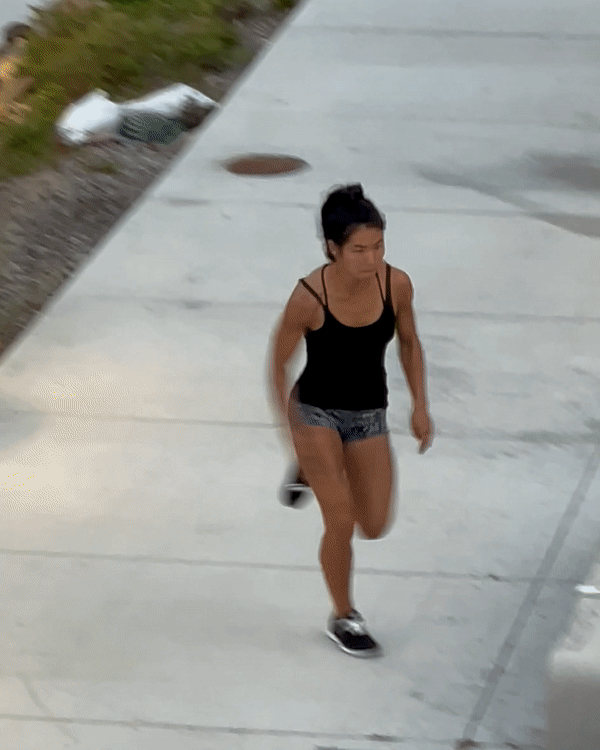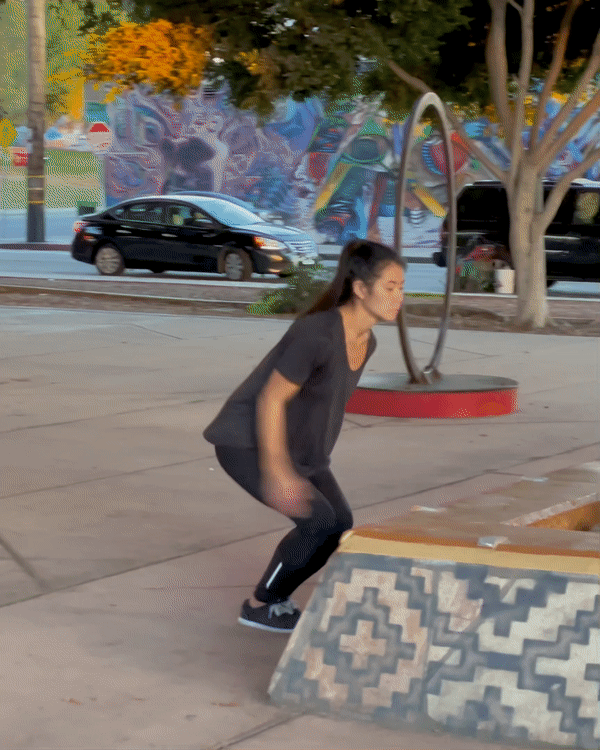Sprinting is 1 of the most undertrained basics in parkour. Big tricks & obstacles often distract from the fundamental sprinting movements that connect & enable big jumps, vaults, wall runs, & other power challenges. Whether you want to build raw speed or parkour skills, sprint training is a simple & effective way to level up. For jump/land athletes who tend to focus more on jump/land training versus sprint training, sprint work may be a catalyst for busting through jump/land plateaus as well.

Sprint applied to speed parkour competition, Apex Denver 2019
ft. Seth Wang
Why train sprints for speed parkour?
- to perform better at speed parkour competitions
- to sprint faster & therefore hit bigger jumps, vaults, wall runs, etc
- to clean up sprint mechanics for increased efficiency
- to bust through plateaus in jump/land skills
- to look less like a derpy dodo bird during running-based skills

Drop to acceleration at Red Bull Al-Andulus 2021
ft. Taylor Carpenter
Warming up for sprint training
Before we get into the drills, you’ll want to make sure you get a good warm-up.
We recommend doing at least a quick 5-10 minute warm-up to get the blood flowing (bare minimum = joint rotations, light running, dynamic stretches, low-impact parkour/movement basics that you already know + 10 chin-ups, dips, single-leg squats, & basic jump/lands).
After that, spend another 5-10 minutes (minimum) working through some relevant, dynamic movements such as:
A drills
Through the A walk/skip/run, the full A drill series builds and reinforces fundamental sprinting positions, as well as general timing & rhythm that are key to getting faster. Start slow & steady with the A walk, and eventually build your way up to the faster, higher-impact A skip & A run. For best results, occasionally change up your A drill training with different surfaces, directions, & rhythms.
Starts & acceleration

Accel/decel applied at 2021 US finals of World Chase Tag
ft. Olof Wood & Omar Zaki
source: SportsCenter
Sprint
Sprinting is a whole-body skill, demanding strong legs, core muscles, and arms. The purpose is to get you across the ground as fast as possible, and when it comes to parkour strength training, it should have a common presence in your workouts.
It’s possible to start a sprint from many different positions, but once you start to accelerate, all sprints tend to look the same. You begin accelerating with your head down and angled forward at your torso so that your legs push the ground behind you, propelling your body faster and faster. After a handful of initial steps, your chest naturally rises to vertical. Pumping your arms in sync with rapid foot strikes ensures that you keep your speed up. Work on the rapid turnover from one foot to the other, and note how you should be on the balls of your feet for the entire duration of the sprint.

Sprint (up stairs)
ft. Taylor Carpenter
Bounding
Along with sprinting, bounding is 1 of the simplest, most effective ways to build single-leg speed & power. Think of it as elongating the strides of your sprint, trying to push the ground behind you for max distance on each step.
Bounding with a double-arm swing will help you cover the most distance possible. However, you may want to opt for the smoother single-arm swing technique if you need to stride across submaximal gaps, or with more balance & precision (e.g. when moving across large gaps on rails).

Coronado stride/bound mission
ft. Olof Wood
Worth a mention
Dribble
Dribbles are a useful running drill in which you cycle your feet in a circular motion (ankle/calf/knee high & walking/running pace). Dribbles help improve your rhythm, coordination, & stiffness needed for stronger/faster sprints. If you’re too sore or injured to sprint, or if you’re taking a rest day, dribbles are also a productive low(er)-impact way to encourage active recovery & skill training. Focus on cycling your legs smoothly, striking the ground actively, keeping an upright posture, etc.
Variations & progressions:

Dribble run (calf-high)
ft. Taylor Carpenter
Wall sprint
Wall sprint drills simulate a forward-leaning sensation, recreating key positions seen in accelerating type movements. By leaning into the wall, explosively switching legs, & freezing into good positions, you soon learn where everything needs to be lined up for accelerations & sprints.
Eventually, these drills serve as a simple, highly accessible part of training speed/power basics/warm-ups/workouts. Start with a walking speed & smooth switch. As you feel ready, gradually ramp up your speed & power levels. Start experimenting with wall sprint triples & quintuples as well.
Variations & progressions:

Wall sprint triple (full speed)
ft. Ryan Ford
Sprinter landing
Practicing various movements to sprinter landing builds speed & coordination for complex jumping/landing/ascent combos. Specifically, it mimics the mechanics of connecting a single-leg landing into a sprint/stride/jump or a top-out/climb-up to sprint/stride/step-up.
By moving quickly into sprinter landing, you learn to optimize key posture/positioning elements like knee drive, ankle dorsiflexion, arm/leg reciprocation, etc. By stabilizing as fast as possible at the top of each rep, you also learn rhythm & relaxation for max power & efficiency.
As you get better at sprinter landings, gradually land higher, knee drive quicker, & freeze faster. Experiment with this same sequence in other formats like broad/box jump or top-out/climb-up to sprinter landing. If you’re struggling to control the landing or coordinate your limbs, revisit sprint mechanics drills like A walk/skip/run.
Variations & progressions:

Standing box jump → sprinter landing
ft. Taylor Carpenter
Want to learn more about sprinting, acceleration, & more plyometric movements to help boost your speed & power levels? Check out Parkour Strength Online, the 80/20 of what you should know about parkour strength & conditioning, in a new & improved digital format. Building upon our 15+ years of research & development across multiple parkour schools IRL & remote, this course will help you accelerate athletic development, mitigate injuries, & expand coaching skills.
Ryan Ford is founder of Apex School of Movement, director of Parkour Strength Online course, & author of Parkour Strength Training book.

